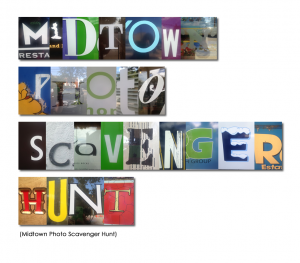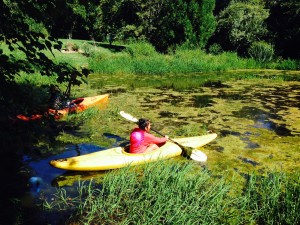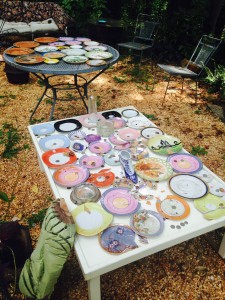Building Experiences is holding a Youth Conference in January and we’re hashing out the structure of the weekend. One student has been vociferously requesting a scavenger hunt so I’ve been trying to figure out an authentic way to include her request in the weekend’s agenda. The scavenger hunt is still in development, but here are some creative ways that I’ve been thinking about modifying the structure:
Category Archives: Games
2 Ways 2 Play (Midtown Photo Scavenger Hunt Preview!)
When you attend the Midtown Street Fair this Sunday, September 21 from 1-6pm, presented by the Midtown Business Association (with a tremendous amount of work by the indomitable Laura of the Blue Moon Diner), you MUST play my street game “Midtown Photo Scavenger Hunt”. It’s gonna be fun!!! Below are rules for the phone-full, and the phone-less.
How to Play (21st Century Rules)
- Go to the event on the Facebook page.
- Look at the pictures posted in the Scavenger Hunt Album (on Sunday, over-eager peeps!)
- See if you can find each of the letters on the West Main Corridor.
- Take a picture with yourself in the picture.
- Post on the Midtown Charlottesville Facebook Page and/or the Midtown Street Fair event page.
- Gloat over your cleverness.
How to Play (20th Century Rules)
- Pick up a paper copy of the Scavenger Hunt.
- Write the business/location of the photo on the respective line.
- Gloat that the NSA probably hasn’t been tracking your every footstep for the last hour (at least through your phone).
- Go buy a smart phone.
And no, no prizes, just satisfaction and fun. Next year, baby!!
For the Designer Types, there’s some further words below.
Purpose
- Engage and entertain visitors to the street fair
- Encourage visitors to walk the length of Midtown by having photos from all 5-6 blocks
- Promote visibility and awareness of businesses
Required Supplies/Resources
- Website/Facebook (design, 21st)
- Smart phone camera (design, 21st)
- Printable copies (20th)
- Graphics program for picture cropping/arranging (design)
This was a delightful, relatively lo-fi game to design. As usual, a lot of designing went on in my brain. Initially, I was going to post little plastic figurines around mid-town and allow children to collect them, but that required collecting stuff, and hiding it around the day off– too much work when I knew that there would be plenty of other tasks that morning. I started thinking about the beauty of signage– and then thought– wait the businesses have letters! And then I thought, what could it spell? Ah, Midtown… It then took a brief walk to find fetching letters to illustrate my words!
If you liked this game, remember I am available to design custom games for your special event! Please contact me at info@wigglelearning.com!
EpiCroqueTournament
I love designing and playing games, and I love hosting parties. For a large friends and family party I wanted to design something unique and fun for the guests to do. Just like when I design a learning game, I went through a fluid, yet familiar design process.
Objectives
- All-ages play
- Easy to follow rules
- Everyone feels successful
- Play would take about an hour
- Play would result in exploration of the family property
Process
As I begin a design, I think about 2 major pieces– what are my resources and what should the participant gain. The Joseph Compound is rife with stuff– how could I use it to make a fun experience. I knew that we had tons of partial croquet sets around, but I knew that I didn’t want to play traditional croquet. There was too much structure– turn-based, winning and losing, a standard wicket set-up… It was important to establish that this was nothing like croquet. I took inspiration from the board game Cranium where players would perform different tasks within drawing, singing, acting, etc. As players hit the ball through a wicket, they would perform a fun task that was described with a poem. The task took away the focus on the traditional counting of strokes, and instead focused on the satisfying smacking of the ball by the mallet, strolling about the grounds, and laughing with one another as shared silliness abounded. Without the competitive element, people could opt out of any activity that was uncomfortable to them.
Results
Over the course of two weekends, about 40 people played EpiCroqueTournament. It exceeded all of my expectations– including getting positive reviews from two of the most demanding critics, my older brother and first cousin, neither of whom are easily satisfied. Players laughed, got engrossed in activities, ventured further afield than the food and drink stations. Some players went on a boat for the first times in their lives.
Lessons I would take away are:
- Fun and enthusiasm in design translate to the playing experience. I talked up the game in social media, even tho it wasn’t completed. People came ready to play because I was.
- Editing is ALWAYS good. I deleted several activities which were simply too much work for me, were too complicated to perform or weren’t seeming fun.
- Use what you have. The particular working parts of EpiCroqueTournament fit into a paper bag. There are a lot of other materials that I brought to the game, but they were mostly already on the landscape. Granted, we’ve got a lot of weird stuff, but I bet you do too.
Too Many Apps
It’s only been four years since the Apple app store was launched, but there are over a half million apps available. In addition there are also all the apps that are embedded in websites and in Google’s store. How do we possibly focus on getting our key tasks done while being told that we need to try this or that new life-changing app? Here are some techniques that I’ve been using to good effect:
Reading Headlines
I don’t read every blog and article the moment it comes out. If I read tech blogs everyday I’d get whiplash. Every new app and tech company is going to change the world. Except they don’t. I wait for the hue and cry to die down and let others weed out the technologies that won’t last. I resist the need to try every last fix-all solution by remembering my History of Ed Tech professor showing us the lantern slide, blackboard, tape player, TV, etc that was going to change the education world and bring in a golden age of human development.
Asking Questions
When a technological break-through lasts long enough to make it worthwhile to invest, I ask friends who I respect what the educational applications are, what the limitations are, and what’s the likelihood that it’s going to be around for a while. Even if there is no cash cost for using a tool, the time and energy that a user spends learning the tool has a price and that becomes a complete loss if the app is going to be absorbed or cut (e.g. Google Wave).
Rejecting Tools (even popular/useful ones)
There are some services that I don’t I need. Spotify is probably great, but I haven’t been convinced that it will add value to my life. I like music, but I’m not an audiophile. I often want it to provide background to other productivity. I mostly don’t want it to bother me. I’ve collected a pretty good iTunes library and I’ve curated some pretty great Pandora stations. I know that Spotify probably is great, but I’m cheap– I don’t want to add another subscription to get the features that really set it apart from competitors. I also want to minimize the amount of time that I spend taking care of my technology– each app that we install means another tool with its own updates, subscriptions to manage, privacy to consider. When we adopt and adopt again we’re devoting more of our time to means not the ends. I’ve got 3-4 ways to listen to music I like already, I’m not sure that I need to add another.
Following Instincts
Sometimes a new app just seems great, a no brainer. If it’s appealing, easy to use, with a clear educational component– then yes, I use it– hello Bitstrips.com. I don’t reject apps just because they’re new. I’m not a crazy luddite. I hope that I am merely a thoughtful luddite. Following my instincts has made me reject any locator type program like foursquare as creepy and unneeded even before I read articles like this.
Investigating on Need
I figure out what I need to do before searching out the app. I don’t find an app and try to shoehorn it into a curriculum or task just to say that I used something new. Using this method we’ve found apps to calculate percentage change, to create secure passwords and teach students how to use javascript.
One technique that has proven invaluable for me is accepting that I can’t stay abreast of every innovation. I shift the focus back from the shininess on the web, and back to the reality of what I really want to do and accomplish. Freeing myself from being an early adopter has definitely reduced my anxiety about what I am missing.
Strategic Play
Part 4 of a six-part series reviewing examples of the six activity modes.
Strategic Play emphasizes the manipulation of resources – military, financial, or “human” – over a longer term. In games that emphasize problem-solving, achieving pre-set goals determines progress, while games that encourage a strategic mode of play often enable players to select their own or the computer’s benchmarks. Games with strategic activities include The Sims, titles in the Tycoon series, Civilization, and the Age of Empires. Few educational titles have incorporated this play mode.
I love strategic play, but I am only semi-good at it. To excel at strategic play, you must be able to see the multiplicities of options and how your decisions now affect future fortunes.
Desktop Defense: This is my favorite online strategic game. The player is given a starting pool of money to purchase or improve towers which then are placed on the game board to prevent the egress of little blobs of different types. As these blobs are stopped, the player gets more money to spend on the defensive towers. This is a common set-up for strategic games; another good example is Bloons Tower Defense with monkeys and balloons, always a winning combo.
A simple-to-learn, hard to master board game is Othello, which is a territory-capture game. Here two players are assigned a color, black or white. The players gain territory by placing their color to capture the other color between two of their own. These tiles get flipped — exposing the player’s color, and hiding the opponent’s. Play continues until all squares are filled. The exposed colors are tallied and whoever has the most wins.
Many games categorized as Role Playing Games (RPGs) contain a good bit of strategy. Based upon the Dungeons and Dragons games popularized in the ’80s, RPGs, such as Monster’s Den, have the player form a party of characters of varying strengths and weaknesses. These characters have human personas — pictures, names, and types, but really are a series of statistics that the player controls through add-ons found mostly through pillaged treasure and reward. Often cast in a mythological world, character death is temporary and nullified through use of potions or spells. Ensorcelled armor or weaponry improve the stats of the character.
Social Play
Part 6 of 6 on an ongoing series about the six activity modes.
Social Play takes several different forms, all centered around social interactions between players, avatars and opponents.
One form of social play is the control of characters in interactions with other computer generated characters, a la old school The Sims. This seems to have been replaced by the more interesting (maybe) interactions of avatars controlled by humans in online environments like Second Life. People can meet strangers, develop relationships, even get married in these virtual communities. These interactions are set apart by their representation of 3-D avatars which can interact in a virtual world.
Another kind of social interaction is the live chats which can take place in a variety of online forums. Again, here, the player can interact with a friends and strangers, but here it takes place with a text dialogue. Typically it is external to the game play.
Multiplayer games allow all sorts of cooperation and competition between players. Sometimes players will alternate between competing and cooperating with the same groups of players.
Often in digital games we concentrate on the controlled interactions that we create, but there are a great number of interactions that happen outside of the planned gaming environment. I often observe the coaching and tutoring that goes on between people in the same physical environment. While it is easy to design for one player per station, oftentimes players enjoy cooperating and sharing the same station. I also will model how to use a game or an activity on a station to elicit excitement and engagement with students. Let’s not forget that a people still like to interact in real life together.
Problem-Solving Play
Part 2 of a 6 part series reviewing examples of the 6 activity modes.
A review of Problem-Solving play:
Problem-Solving play is commonly encouraged via inclusion of puzzles, both in educational games and in commercial titles such as Myst. Here, there are specific rules for the activity sequence and the solution to the challenges. Even if there are a number of challenges within a given game, they are generally well defined, and undertaken independently. The problems may be hierarchical, requiring one problem to be solved before moving on to another, or the problems may be parallel and unrelated. Problem-solving may be fast-paced and reliant upon hand-eye coordination, or it can take a slower form where logic prevails.
Factory Balls 2 I lurve this game. Using a variety of tools, the player transforms white balls into 30 colorful variations with stencils and paints. Players must perform the transformational steps in a particular order in order to create the proper effect, but are not pressured by any time limits.
Little Wheel Here you look for a series of step by step puzzles hidden within the scenery. Like Factory Balls there is a particular sequence of steps to follow, but the ingredients and elements are hidden. I never can fathom these games.
Meta Games: This is the Only Level, Obey the Game and Take Something Literary play with the notions of game play and require players to solve puzzles that are fluid and require the knowledge of gameplay conventions. Novelties or deep exploration of game play? You decide.
Balance games: Tons and Tons of these. Red Remover, Super Stacker 2, Splitter 2, and Perfect Balance 2 are just a few of the different ones where the player attempts to balance or unbalance objects in a worlds with consistent physics. These may have time constraints or not.
Light-bot:Use programming commands to cause a robot to follow different sequences of action. Like the Logo for this decade.
Matching games: Bejeweled and Bubble Shooter are two of the most famous, but most feature matching 3 more objects with like characteristics often with a time component.
There are tons more games with problem-solving activities. Game rules are typically fairly simple and straight forward. Problem-solving is easily combined with Active, Strategic and Explorative activities.
Creative Play
Part 5 of 6 of an ongoing series about the six activity modes.
Creative mode activities are sometimes hard to find within what we would consider the integral part of game play, but it often appears as a precursor or reward to game play. How many games have the option to dress the avatar before gameplay commences or reward the player by purchasing items and decorating their hideaway? This manipulation has taken the spot that paper dolls or make-up mannequins held during my childhood. Both boys and girls engage in this activity, but I certainly observe girls spending hours dressing their characters.
Marvel’s Create your own Super-Hero certainly appealed to this comic book-loving geek, but it has some of the inherent issues in these templatized activities. The player can only choose the typical female super hero body– pneumatic breasts not effected by this world’s gravity. Tall and lean, both the male and female bodies are completely unrealistic, but you are not limited in your color palette, making it possible to choose features and skin tone of any race. The brief Google search for dress-up games yield TONS of hits, but the majority were white, very thin images. Be cautious when designing your own avatars and be more inclusive, please.
The Sims, Roller Coaster Tycoon and all the tremendous numbers simulation games were ultimately just vessels to create different worlds. While there were different challenges, a great deal of fun was had creating a personalized world with a color scheme and layout at the discretion of the player. It was not a huge coincidence that it was called a “god’s eye” perspective.
I’ve long thought that Andy Deck’s stuff was odd, interesting and thought-provoking. Here at Collabyrinth, he lets people create icons and then publishes them into a maze that displays the most recent users’ work.
Moving into the music world, this activity allows children to easily create music and sounds.
Finally, in Copy Cat, players recreate the images that appear on the screen. More of a problem-solving than a pure creative task, it does include aspects of color theory and the breaking down of space necessary for certain kinds of artwork.
I’m well aware that the activities for this blog entry are not strictly games, but I do think that these links provide activities that are compelling for a lot of users– and that it’s important to include opportunities for learners to create in free-form ways. Oftentimes as designers, we (or our employers) have a strong desire to lockdown the learner experience to predictable paths. Including creative activities challenge that structure.
Explorative Play
Part 3 of a six-part series reviewing examples of the six activity modes.
Another activity mode widely experienced in games is explorative play, where physical space and travel is simulated through the layout of the game arena. By hiding certain areas from view, the player is allowed to discover new areas and challenges in turn. Explorative play can be easily modified by the addition of other activity modes. Many three-dimensional “shooters” combine active and explorative play, where players find their way through virtual buildings or cities while dodging bullets and shooting enemies. Slower-paced educational games often pair exploration of an area with problem-solving activities.
I personally dislike explorative play. It makes me anxious because I don’t know what’s around that corner or in the hidden parts of the game board. I love Civilization. The first time I played Civ3 I played for 10 hours and then realized that I didn’t know what I was doing. Finally aware of the actual rules, I played for another three hours. Similarly when Civ4 came out I played til dawn one long night. But the initial stages of the game — the time where you send explorers out to scout the edges of the world with a completely hidden topography holds no appeal to me. Sure, there’s treasure and unknowns, but those things can be scary and dangerous as well.
In Little Wheel, the player explores the game space by solving puzzles and problems. Successful players are taken to another game space to undo other puzzles. Myst is the best known of these types of puzzle games.
Second Life is, of course, a social experience at heart, but it also incorporates a large amount of exploration of space and environments. In virtual worlds, people navigate their avatars through areas, discovering new spaces and interacting with objects by flying, walking, running, and jumping.
Bubble Tanks is a shooter that takes place within a series of contiguous bubble realms. Rather than experiencing player death, the player’s bubble tank is spat out to another bubble once its power has diminished.
The key to the explorative mode is understanding that not all options may be available simultaneously, and rarely is there a tiered, linear progression through levels. The explorative mode allows the player to feel in control of their movements through a larger space.
Active Play
Earlier I blogged about the 6 activity modes. Over the next few posts I am going to present some examples of games that highlight each of the activity modes. Today the focus is on Active Play. For those of you who don’t want to exercise the power of links or the scroll bar, here’s a review:
The gameplay mode most often thought of in connection with computer and video games is the active mode. In this mode, the player must respond quickly, using rapid-fire techniques, “twitch” speed, and combinations of keys or buttons to achieve the goals of the game. The game clock and/or threat of character “death” often provide structure and consequences. In games that shape play around action, the story lines frequently emphasize dichotomous conflict where the player embodies good against an evil opponent. Many of the most popular commercial games, including “shooters”, arcade-style games, and puzzles incorporate active modes into their game play.
The following games are quite different from one another in subject matter, game controls and genre, but they all incorporate active play.
Upgrade Complete I typically hate shooters, because I have no twitch speed, but this one has an interesting purchasing aspect. As you play you earn points that allow you to upgrade from a bare-bones Atari style game to a jazzy modern shooter with pretty graphics.
Word Bubbles This fast-paced word game requires you to form words with the same 3 beginning letters in a limited amount of time. I tend to find it addictive.
Typing of the Dead Awesome! A typing program that has makes your “ASDF” blast and explode zombies.
Tetris The classic combo of active and problem-solving play. You know you want to practice your spatial reasoning.










